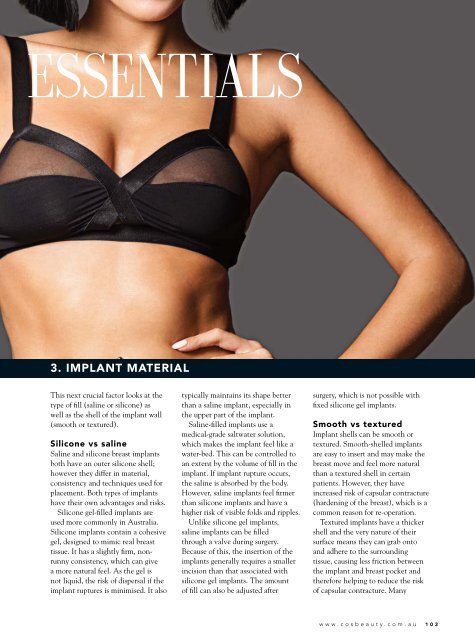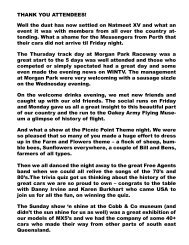CosBeauty Magazine #85
CosBeauty is the #BeautyAddict's guide to lifestyle, health and beauty in Australia. In this issue: - The Breast Report - your guide to augmentation - Put an end to bad hair days - 24 hour makeup, products that last - Sex appeal - do you have it?
CosBeauty is the #BeautyAddict's guide to lifestyle, health and beauty in Australia.
In this issue:
- The Breast Report - your guide to augmentation
- Put an end to bad hair days
- 24 hour makeup, products that last
- Sex appeal - do you have it?
Create successful ePaper yourself
Turn your PDF publications into a flip-book with our unique Google optimized e-Paper software.
essentials<br />
3. Implant material<br />
This next crucial factor looks at the<br />
type of fill (saline or silicone) as<br />
well as the shell of the implant wall<br />
(smooth or textured).<br />
Silicone vs saline<br />
Saline and silicone breast implants<br />
both have an outer silicone shell;<br />
however they differ in material,<br />
consistency and techniques used for<br />
placement. Both types of implants<br />
have their own advantages and risks.<br />
Silicone gel-filled implants are<br />
used more commonly in Australia.<br />
Silicone implants contain a cohesive<br />
gel, designed to mimic real breast<br />
tissue. It has a slightly firm, nonrunny<br />
consistency, which can give<br />
a more natural feel. As the gel is<br />
not liquid, the risk of dispersal if the<br />
implant ruptures is minimised. It also<br />
typically maintains its shape better<br />
than a saline implant, especially in<br />
the upper part of the implant.<br />
Saline-filled implants use a<br />
medical-grade saltwater solution,<br />
which makes the implant feel like a<br />
water-bed. This can be controlled to<br />
an extent by the volume of fill in the<br />
implant. If implant rupture occurs,<br />
the saline is absorbed by the body.<br />
However, saline implants feel firmer<br />
than silicone implants and have a<br />
higher risk of visible folds and ripples.<br />
Unlike silicone gel implants,<br />
saline implants can be filled<br />
through a valve during surgery.<br />
Because of this, the insertion of the<br />
implants generally requires a smaller<br />
incision than that associated with<br />
silicone gel implants. The amount<br />
of fill can also be adjusted after<br />
surgery, which is not possible with<br />
fixed silicone gel implants.<br />
Smooth vs textured<br />
Implant shells can be smooth or<br />
textured. Smooth-shelled implants<br />
are easy to insert and may make the<br />
breast move and feel more natural<br />
than a textured shell in certain<br />
patients. However, they have<br />
increased risk of capsular contracture<br />
(hardening of the breast), which is a<br />
common reason for re-operation.<br />
Textured implants have a thicker<br />
shell and the very nature of their<br />
surface means they can grab onto<br />
and adhere to the surrounding<br />
tissue, causing less friction between<br />
the implant and breast pocket and<br />
therefore helping to reduce the risk<br />
of capsular contracture. Many<br />
www.cosbeauty.com.au 103


















